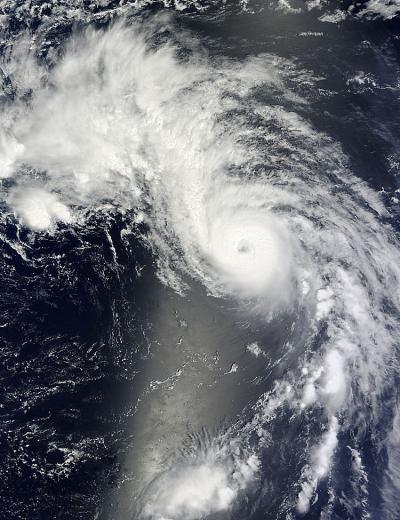Genevieve downgraded to a tropical storm

NASA's Terra satellite captured this image of Typhoon Genevieve on Aug. 9, 2014, at 23:15 UTC. Credit: Image Credit: NASA Goddard MODIS Rapid Response Team
The storm is located approximately 819 nautical miles west-northwest of Midway Island.
It is currently tracking northwestward at 8 knots per hour over the past six hours.
Maximum significant wave height is 32 feet.
Maximum sustained winds 70 knots gusting to 85 knots, with winds of 34 knots or higher occur within 80 to 105 miles of the cente,r and winds of 64 knots or higher occur within 15 miles of the center.
No landmasses are currently threatened by this storm.
Genevieve is moving northwest and has continued to weaken.
Unfavorable environmental factors has caused a rapid weakening over the past 12 hours.
The storm will dissipate within 2-3 days, far southeast of the Aleutian islands.
Text credit: Lynn Jenner
NASA's Goddard Space Flight Center
Media Contact
All latest news from the category: Earth Sciences
Earth Sciences (also referred to as Geosciences), which deals with basic issues surrounding our planet, plays a vital role in the area of energy and raw materials supply.
Earth Sciences comprises subjects such as geology, geography, geological informatics, paleontology, mineralogy, petrography, crystallography, geophysics, geodesy, glaciology, cartography, photogrammetry, meteorology and seismology, early-warning systems, earthquake research and polar research.
Newest articles

A universal framework for spatial biology
SpatialData is a freely accessible tool to unify and integrate data from different omics technologies accounting for spatial information, which can provide holistic insights into health and disease. Biological processes…

How complex biological processes arise
A $20 million grant from the U.S. National Science Foundation (NSF) will support the establishment and operation of the National Synthesis Center for Emergence in the Molecular and Cellular Sciences (NCEMS) at…

Airborne single-photon lidar system achieves high-resolution 3D imaging
Compact, low-power system opens doors for photon-efficient drone and satellite-based environmental monitoring and mapping. Researchers have developed a compact and lightweight single-photon airborne lidar system that can acquire high-resolution 3D…





















